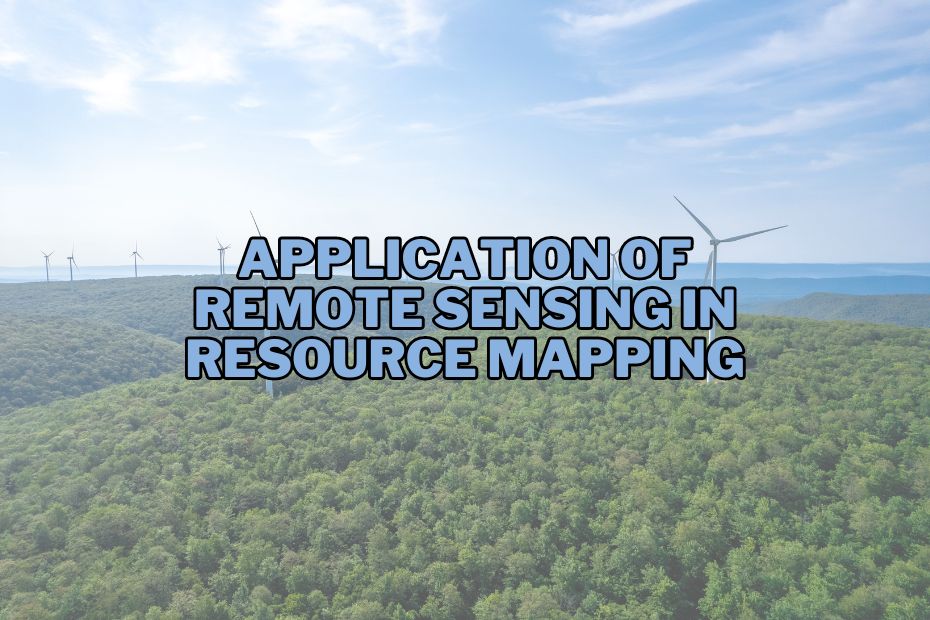In today’s data-driven world, the utilization of cutting-edge technology has become essential for effective resource management. One such technological marvel that has revolutionized the way we understand and utilize our resources is remote sensing. This article delves deep into the multifaceted application of remote sensing in resource mapping, exploring its role in various domains and its impact on decision-making.
Remote sensing is a powerful technology used for resource mapping in various fields. It enables us to assess land use, soil moisture, forest health, water resources, minerals, urban development, and much more.
Application of Remote Sensing In Resource Mapping
From the vast expanses of pristine wilderness to the bustling urban landscapes, the application of remote sensing in resource mapping has emerged as an indispensable tool, unlocking a realm of possibilities for sustainable development and informed decision-making.
1. Land Use and Land Cover Mapping
Land use and land cover mapping are foundational tasks in resource management. Remote sensing allows us to categorize and quantify different types of land use, such as agricultural, urban, or natural areas, and monitor changes over time. By analyzing satellite imagery and data, we gain a comprehensive understanding of how our land is utilized and how it evolves, aiding in urban planning, environmental conservation, and disaster preparedness.
2. Soil Moisture Assessment
Understanding soil moisture is vital for agriculture and water resource management. Remote sensing tools can measure soil moisture content across large areas, helping farmers optimize irrigation, prevent drought-related crop losses, and ensure efficient water resource allocation.
3. Forest Inventory and Monitoring
Forests play a crucial role in maintaining ecological balance and supporting biodiversity. Remote sensing assists in conducting forest inventories, monitoring deforestation, and assessing forest health. This data aids in sustainable forestry management and wildlife conservation efforts.
4. Water Resource Management
Water is a finite and precious resource. Remote sensing provides valuable insights into water bodies, including their quantity, quality, and changes over time. This information is pivotal for managing water resources, ensuring clean drinking water, and mitigating the impact of droughts and floods.
5. Mineral Exploration
Mining and geology benefit immensely from remote sensing technology. It helps identify potential mineral deposits, assess geological features, and plan mining operations efficiently. This reduces exploration costs and environmental impact while maximizing resource extraction.
6. Urban Planning and Development
In rapidly growing urban areas, efficient planning and sustainable development are paramount. Remote sensing aids in monitoring urban expansion, infrastructure development, and population growth. This information guides city planners in making informed decisions for sustainable urbanization.
7. Crop Health Assessment
For agriculture, remote sensing offers a unique advantage by enabling the assessment of crop health and growth. By analyzing spectral data from satellites and drones, farmers can detect early signs of disease, nutrient deficiencies, or pest infestations, leading to more effective crop management.
8. Coastal Zone Management
Coastal zones are vulnerable to various natural hazards and environmental changes. Remote sensing assists in monitoring coastal erosion, sea-level rise, and the impact of climate change. This data is invaluable for coastal zone management and disaster preparedness.
9. Wildlife Conservation
The conservation of wildlife and their habitats is a global concern. Remote sensing aids in tracking animal movements, monitoring protected areas, and assessing the impact of human activities on ecosystems. This information guides conservation efforts to protect endangered species.
10. Disaster Management
In times of natural disasters, timely and accurate information is critical. Remote sensing provides real-time data on disasters such as hurricanes, wildfires, and earthquakes. This data enables emergency responders to plan and execute rescue and relief operations efficiently.
11. Archaeological Surveys
Remote sensing has even found applications in archaeology. It can detect buried structures, ancient settlements, and archaeological features that are not visible on the surface. This technology has revolutionized archaeological surveys and our understanding of history.
12. Climate Change Monitoring
Climate change is a pressing global issue. Remote sensing allows scientists to monitor changes in the Earth’s climate system, such as ice cap melting, sea level rise, and temperature fluctuations. This information contributes to climate research and policy-making.
As we have explored, remote sensing is a versatile and indispensable tool in resource mapping across various domains. Its ability to provide detailed, real-time data has transformed how we manage our resources and respond to environmental challenges. In an increasingly interconnected world, the insights gained through remote sensing are invaluable for informed decision-making and sustainable resource utilization.
Conclusion
The application of remote sensing in resource mapping has ushered in a new era of precision and efficiency. From assessing the health of our forests to tracking the impact of climate change, this technology has reshaped the way we view and manage our resources. As we move forward, the continued development and integration of remote sensing will be crucial in addressing the complex challenges of resource management and environmental sustainability.
FAQs: Application of Remote Sensing In Resource Mapping
Can remote sensing be used for archaeological surveys?
Yes, remote sensing can detect buried structures and ancient settlements, revolutionizing archaeological surveys and our understanding of history.
Why is remote sensing important in resource mapping?
Remote sensing allows for the efficient and non-invasive assessment of natural resources, enabling informed decision-making and sustainable resource management.
What types of resources can be mapped using remote sensing?
Remote sensing can be used to map various resources, including forests, water bodies, minerals, agriculture, land use, and urban development.
How does remote sensing technology work in resource mapping?
Remote sensing technology uses sensors on satellites or aircraft to capture electromagnetic radiation reflected or emitted by the Earth’s surface. Different wavelengths are used to detect various resources.
Can remote sensing help in monitoring deforestation and forest conservation?
Yes, remote sensing can track changes in forest cover, detect deforestation, and support conservation efforts by providing data for forest management.
